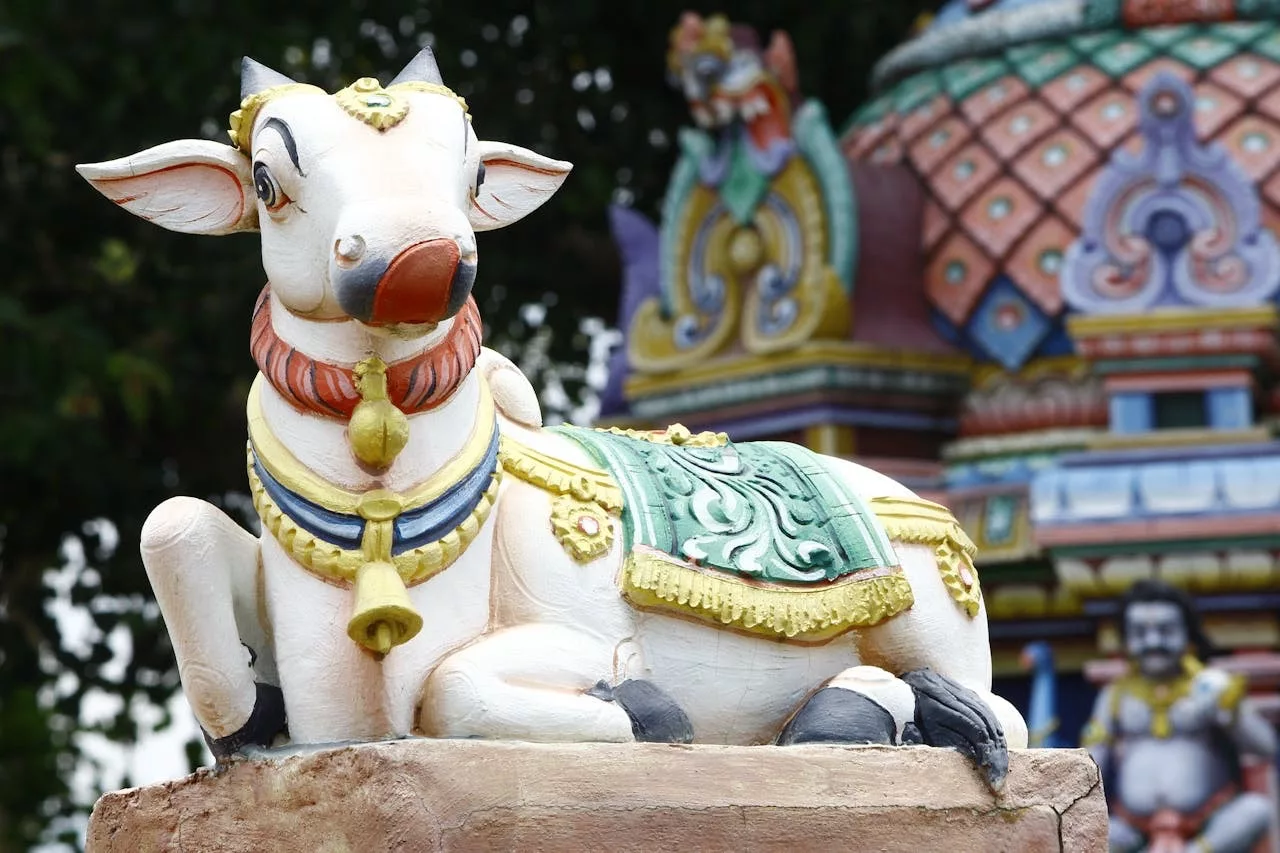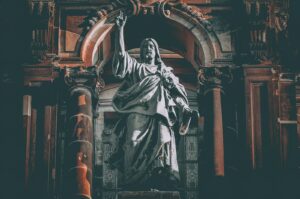The reverence of cows in Hinduism is one of the most well-known aspects of the religion, often symbolizing compassion, abundance, and the interconnectedness of life. For centuries, the cow has been regarded as sacred in Hindu philosophy, serving as a symbol of non-violence and providing essential resources that sustain human life. But why exactly are cows held in such high regard, and what is the basis for their spiritual and cultural importance in Hinduism?
The answer lies in a complex blend of religious texts, historical practices, and philosophical teachings that date back thousands of years. From their association with divine figures to their practical role in agrarian societies, cows embody a deep spiritual and practical significance in Hindu culture. This article will explore the multifaceted reasons behind the cow’s revered status in Hinduism, examining its connections to ancient scriptures, cultural traditions, and modern interpretations.
The Spiritual Significance of Cows in Hinduism
1. The Cow as a Symbol of Non-Violence (Ahimsa)
One of the core tenets of Hinduism is ahimsa, or non-violence, which emphasizes compassion and respect for all living beings. The cow, as a gentle and nurturing animal, epitomizes this principle. By treating cows with care and reverence, Hindus express their commitment to living harmoniously with nature and minimizing harm to other creatures.
This connection to non-violence is deeply rooted in Hindu ethics and philosophy. Ancient texts like the Mahabharata and Bhagavad Gita promote the idea of universal compassion, making the cow a natural symbol of these values. Reverence for cows is not just about the animal itself but also reflects a broader commitment to protecting all forms of life.
2. Association with Hindu Deities
Cows are closely associated with several Hindu deities, further elevating their spiritual status. For example, Lord Krishna, one of the most beloved gods in Hinduism, is often depicted as a cowherd surrounded by cows. In the Bhagavata Purana, Krishna’s life in Vrindavan includes caring for cows, which symbolize abundance, purity, and love. This imagery reinforces the sacredness of cows in Hindu tradition.
Similarly, the goddess Kamadhenu, often described as the “cow of plenty,” is believed to grant all desires and provide nourishment. She is considered a divine manifestation of abundance and fertility, embodying the cow’s role as a life-sustaining force. These associations with divinity make the cow a spiritual symbol revered across Hindu culture.
3. Representation of Motherhood and Nurturing
In Hinduism, the cow is often regarded as a surrogate mother, providing nourishment in the form of milk. This maternal symbolism resonates deeply in a culture that values familial bonds and caregiving. The cow’s role as a provider of sustenance and life aligns with the Hindu ideal of matru devo bhava, which means “revere the mother as God.”
This connection to motherhood extends to the idea of the Earth itself as a nurturing mother, often depicted as “Dharti Mata” or “Mother Earth.” The cow, as a symbol of the Earth’s generosity and fertility, reinforces this relationship, reminding Hindus of their duty to protect and honor both the cow and the natural world.
The Historical and Cultural Role of Cows in Hindu Society
1. The Cow in Vedic Texts
The reverence for cows can be traced back to the Vedic period, around 1500 BCE, when they were considered invaluable assets in agrarian societies. The Rigveda, one of Hinduism’s oldest scriptures, frequently mentions cows as symbols of wealth and prosperity. They were seen as a measure of a person’s affluence and played a central role in rituals and sacrifices.
While some Vedic texts describe the use of cattle in rituals, they also emphasize the importance of protecting and cherishing cows. Over time, the focus shifted from their ritual use to their symbolic and practical significance, laying the foundation for their revered status in Hinduism.
2. The Agrarian Economy and Practical Utility
In traditional Indian agrarian society, cows were indispensable for their practical contributions. They provided milk, an essential source of nutrition, as well as byproducts like ghee (clarified butter), curd, and buttermilk, which are central to Hindu cuisine and rituals. Cow dung served as a natural fertilizer and fuel, further emphasizing their utility in sustaining rural life.
This practical value reinforced the cultural and spiritual reverence for cows. Protecting cows ensured the survival of agrarian communities, making them not only sacred symbols but also vital assets for daily life. This connection between the cow’s practical utility and its spiritual significance continues to influence Hindu practices today.
3. The Shift Toward Non-Sacrificial Traditions
During the later Vedic period and the rise of movements like Jainism and Buddhism, there was a growing emphasis on non-violence and the rejection of animal sacrifice. These movements influenced Hindu practices, leading to a shift in how cows were perceived and treated. Instead of being sacrificed in rituals, cows became symbols of life and purity.
This transition further cemented the cow’s role as a sacred animal, reflecting the broader cultural shift toward compassion and ethical treatment of living beings. By the time of the Upanishads and later Hindu texts, the cow had become firmly established as an object of veneration.
Rituals and Festivals Celebrating Cows
1. Govardhan Puja
Govardhan Puja, celebrated during the Hindu festival of Diwali, is a significant occasion that honors cows and their contributions. Devotees create effigies of cows and worship them alongside Lord Krishna, who is believed to have lifted Mount Govardhan to protect his devotees. This festival underscores the cow’s role as a divine and protective force in Hindu mythology.
During Govardhan Puja, people feed cows special treats and decorate them with flowers and painted designs, expressing gratitude for their role in sustaining life. The rituals highlight the deep cultural and spiritual connection between humans and cows in Hindu tradition.
2. Gopashtami
Gopashtami is another festival dedicated to cows and their caretakers. Celebrated primarily in rural areas, it involves elaborate rituals to honor the cows’ role in agriculture and dairy production. The day is also a celebration of Lord Krishna’s time as a cowherd, emphasizing his divine connection to the animal.
On Gopashtami, cows are adorned with garlands, and their caretakers are acknowledged for their hard work. This festival reflects the symbiotic relationship between humans and cows, reinforcing their importance in Hindu culture.
Modern Interpretations and Controversies
1. Cows in Contemporary Hinduism
In modern times, the reverence for cows remains a cornerstone of Hindu identity. Protecting cows is seen as a moral and religious duty, and many Hindu families continue to offer prayers to cows or incorporate them into daily rituals. Cow shelters, or gaushalas, have been established across India to care for abandoned or aging cattle, further emphasizing their sacred status.
However, this reverence also faces challenges in a rapidly modernizing society. Urbanization and industrialization have altered traditional agrarian lifestyles, and the practical role of cows has diminished in some areas. Balancing traditional values with modern realities remains a complex issue for many Hindus.
2. Political and Social Controversies
The sacred status of cows has also become a point of political and social contention in contemporary India. Cow protection laws, which prohibit the slaughter of cattle in many states, have sparked debates about religious freedom, secularism, and economic impact. Critics argue that these laws disproportionately affect non-Hindu communities and farmers who rely on cattle trade for their livelihoods.
Despite these controversies, the reverence for cows continues to hold a central place in Hindu culture, symbolizing the enduring connection between spiritual beliefs and daily life.
Conclusion
The reverence for cows in Hinduism is a multifaceted tradition that intertwines spirituality, culture, and practicality. From their association with divine figures like Krishna and Kamadhenu to their essential role in sustaining agrarian societies, cows embody values of compassion, abundance, and interdependence. Their sacred status reflects not only religious devotion but also a deep respect for the interconnectedness of life.
While modern challenges and controversies have added complexity to this tradition, the cow remains a powerful symbol of Hindu identity and philosophy. Understanding the cultural and historical significance of this reverence helps illuminate the broader principles of Hinduism—principles that emphasize harmony, non-violence, and gratitude for the natural world.




